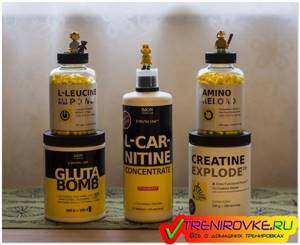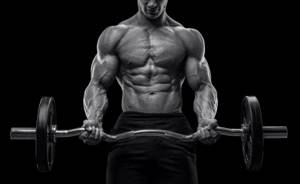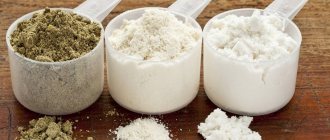Take creatine for better results ( 7 votes, average: 3.86 out of 5)
Creatine monohydrate was first used back in 1992, and since then this sports supplement has been very popular among athletes. Let's figure out what creatine is. Creatine is a kind of acid that was obtained from amino acids. How does creatine work?

Creatine and its side effects
Creatine helps athletes perform quite large volumes of work; a person who takes creatine can do much more exercise than a person who does not take this drug. You can find out what effect creatine will have on you from our article.
Taking creatine is necessary for those athletes who want to increase their muscle mass and muscle strength. Creatine is very popular today among athletes, since this drug tends to be synthesized naturally in the body.
What effect does creatine have? It increases the energy potential of the muscles, as well as endurance and strength, and promotes the growth of lean body mass. If you compare creatine and protein as providing your muscles with energy, then naturally creatine will outperform protein. With creatine, your muscle mass can increase by up to 20 percent.
Effect #1 of creatine
With the help of creatine, muscle hypertrophy is greatly increased. Although creatine has been used by many athletes for many years, many studies on the effect of creatine are still being conducted on the drug.
In the first discovery of the drug itself, it was initially found that creatine powder only helps to increase the body's endurance during training.

Research has shown that creatine also helps those who have a number of problems with muscle loss.
Creatine affects muscle hypertrophy due to the fact that it can retain water in the body. But, later it was discovered that creatine actually helps to increase muscle mass in the body.
What is Creatine Monohydrate?
Creatine Monohydrate is a natural substance that is converted into Creatine Phosphate in the human body. Creatine Phosphate, in turn, is involved in the production of ATP, which provides energy for muscle contraction during exercise.
Our bodies make creatine on their own and also get it from foods like red meat and fatty fish. However, your own resources may not be enough, and the amount of creatine in foods decreases during cooking.
Creatine Monohydrate is a sports supplement containing pure creatine, used before/after training and/or together with other sports nutrition products (for example, together with whey protein).
Side effects when taking creatine
If you start taking creatine, then be prepared for the fact that the body will need a lot of time to remove water from the body, so water retention will occur in the body. This problem affects almost every athlete who has tried creatine. But, it is necessary to understand that water retention in the body does not negatively affect the human body and this is not accompanied by swelling on the face, but is noticeable only on the scales.

Side effects when taking creatine
- It must be remembered that in no case should you consume less fluid or drink diuretics if you are delaying the removal of water from the body, as this will harm your body. Digestive disorders are one of the most common side effects from taking creatine and may be accompanied by nausea, diarrhea, and abdominal pain. Most often this happens at the stage of loading the body, when it is necessary to take fairly large doses of creatine. These side effects from creatine monohydrate occur due to the fact that creatine crystals dissolve very slowly in the human stomach.
- Digestion may also be affected if you bought poorly purified creatine, so it is better to choose expensive companies that have good reviews. There are many articles in various newspapers and the Internet about cramps from taking creatine, but in practice this happens extremely rarely. Many investigators believe that taking creatine cannot cause cramps or spasms.
Most often, muscle spasms occur from muscle dehydration while taking creatine; to prevent this from happening, naturally, you need to consume more fluid. If we consider cramps, they can occur because the muscles have more load during training, and during rest, spasms may occur as a kind of recovery reaction of the body.

Best Creatine for Beginners
Acne or pimples may also appear on your face from taking creatine, but this is extremely rare. Creatine monohydrate may cause side effects such as acne and may be due to an increase in testosterone levels in the body, but this will show you that the drug is working and muscle mass is increasing.
On the Internet today you can see many non-existent side effects from taking creatine monohydrate. So, blood pressure cannot rise from taking creatine. The most popular myth is that creatine leads to infertility and reduces potency; this is not true. Creatine also does not affect the heart and is not addictive.
Method of taking creatine, dosage size
There are a huge variety of methods and dosages for taking creatine. Only to the question of how much creatine to drink, the answer has already been found - up to 50 mg per kilogram of weight. Our body will simply remove the excess from the body.

Substance use patterns are divided into “loading” and “no loading”. Their meaning is as follows:

With the loading method, creatine is taken small and often. Thus, the authors of the method claim that you can absorb more micronutrients than usual.

The no-load scheme is more common and, according to athletes, much more effective. Using it, creatine is taken once, the entire portion at once. On training days this happens after exercise, and on weekends - in the morning on an empty stomach. After training, it is best to drink creatine with natural juice.

Taking the substance does not negate the ability to take amino acids.

The main thing is to consult with a specialist to draw up a consumption schedule. Among professionals, the combination of creatine and amino acids is commonplace.

How to take creatine for the best effect?
You can take creatine according to the scheme that we will give you later in the article. So, if you have just started taking creatine, and the first week of taking the drug has begun, then you need to use it 4 times a day. It is also possible that side effects from creatine may occur if the dose of the drug is increased. The dose of creatine should be 5 grams per dose, which is 20 grams per day. To better absorb creatine in the body, you can drink it with one glass of any juice.
Take creatine for best results
After the next 3 weeks, you need to take the drug only before training and 5 grams per day. After the end of the month, you need to take a break for a month. After which you can start taking creatine. But, the dosage will be changed: before each workout, namely an hour before training, you need to take 30 grams of creatine. If you do not have a workout that day, then creatine must be taken on an empty stomach.
If you have heavy load training, then you can increase the number of doses of the drug up to 4 times a day. On the Internet you can see many photos that show the effect of taking creatine. If you follow this regimen, then within a month you will be able to see the effect of taking creatine.
The ratio of creatine intake and training (before and after)[edit | edit code]
Related article:
How to take creatine (the scientific approach)
A study of the effect of course use of creatine monohydrate in different phases of the training process was carried out by J.Antonio and V.Ciccone[25]. The importance of the phase of administration of creatine monohydrate before or after training has specific practical implications. This postulate is based on previous studies that have shown, in particular, that the complex of essential amino acids is more effective in increasing muscle protein synthesis when used (during a course of use) before the start of training than after its completion [26]. P. J. Cribb and A. Hayes [27] showed that taking a protein-carbohydrate-creatine supplement immediately before or after exercise significantly increased TMT, muscle fiber size and muscle strength compared to taking this combination simply in the morning or evening. The study was performed on 19 healthy male bodybuilders (age 23.1 ± 2.9 years; weight 166 ± 23.2 cm; weight 80.2 ± 10.4 kg), who were randomized into two groups: immediately before or immediately after training they took CM at a dose of 5 grams. The subjects trained on average 5 days a week, the qualitative and quantitative composition of the loads corresponded to the average statistical load of a bodybuilder for all muscle groups. When analyzing macro-indicators, a tendency was revealed in the group with creatine monohydrate towards a decrease in body fat mass and an increase in bench press values. More accurate mathematical processing of the data obtained showed the advantage of creatine monohydrate when taken in the post-workout (post-load) period than when taken before training, although significant positive changes in most indicators are observed with both options for using creatine monohydrate: an increase in body weight and muscle strength.
Combined use of creatine and whey protein[edit | edit code]
The purpose of this work[28][29] was to study the effects of whey protein (WP) and creatine monohydrate (CrM) (individually and in combination) on body composition, muscle strength, hypertrophy of individual muscle fiber types (in particular, I, IIa, IIb) and the accumulation of contractile proteins during constant physical training. The double-blind, randomized study included well-trained men divided into 4 groups: creatine/carbohydrate (CrCHO); creatine/WP (CrWP); WP only (WP); carbohydrates only (CHO) (1.5 g/kg body weight/day). All measures were assessed one week before and one week after the 11-week specific training program and included: maximal strength (best lift of three attempts with increasing weights - 1RM); body composition (DEXA) – lean body mass (LBM), fat component; muscle analysis - biopsy (100-450 mg) of the lateral thigh muscle to determine muscle fiber type (I, IIa, IIx), cross-sectional area (CSA), contractile protein content and creatine (Cr). Dietary supplementation with CrCHO, WP and CrWP resulted in a significant (P<0.05) increase in maximal muscle strength and muscle hypertrophy (up to 76%) compared to CHO. However, the hypertrophic response to nutritional supplementation varied significantly between groups in terms of the recorded parameters (TMT, specific fiber hypertrophy, contractile protein content). The authors conclude that although WP and/or CrM stimulate gains in muscle strength and improve muscle morphology during chronic training, The hypertrophic response varies among individual groups. These differences may have important practical implications and require further research. Today, the combination of WP creatine and other types of proteins is a common option in elite sports.











